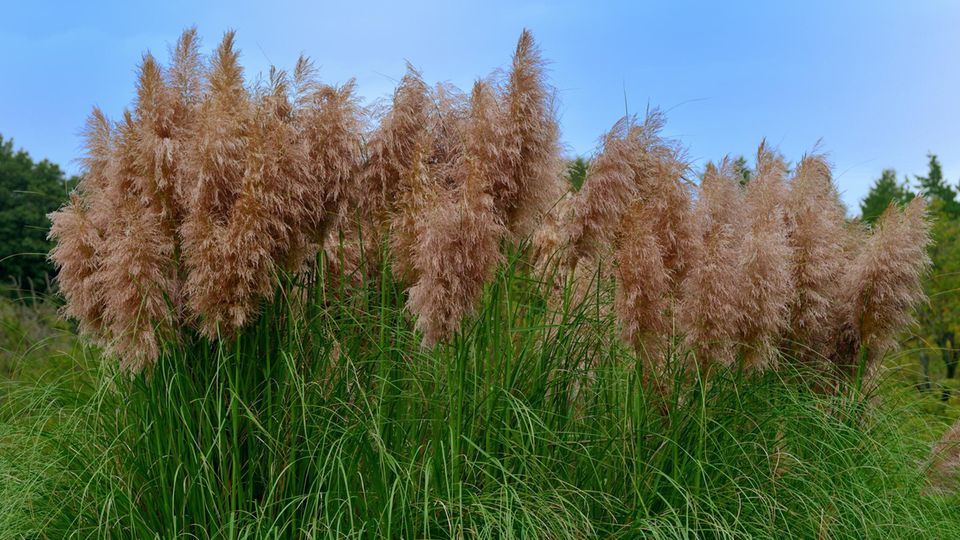Cortaderia selloana
Cutting back pampas grass in spring: This is what you need to keep in mind
White pampas grass is a beautiful eye-catcher in the garden
© Getty Images
Pampas grass, which comes from South America, is a phenomenon – more precisely, it is its flower spikes that exude an exotic flair in every garden. In order for the plant to maintain its opulent appearance, it should be cut back in spring and cared for properly.
While the pampas grass leaves do not grow to any significant height, the flowers reach up to two and a half meters towards the sky – but only in the summer months, usually around August, but into the winter. Since the plant comes from warmer climates, it prefers a sunny location in the garden. Ideally, this is also protected from the wind so that the long stalks do not break on stormy days. Otherwise, American pampas grass is quite easy to care for, but it still can’t cope without help: so that the plant can show off its most beautiful side, it is important to cut back the ornamental grass in spring. Everything you need to know about the plant (from care to pruning to overwintering) can be read here.
Plant pampas grass
Regardless of whether you have an ornamental grass white or pink ones If you want to plant flowers in your garden – the following tips apply to both varieties: As far as location is concerned, the plant prefers nutrient-rich and permeable soil so that waterlogging (and thus rot) cannot form. If the soil is very solid, it can also be enriched with sand. However, if there is a lack of nutrients, compost soil should be added to the humus-rich soil – preferably combined with one Fertilizer for ornamental grasses. The best time to plant pampas grass is spring. After the Ice Saints. This gives the plant enough time to grow before the temperatures drop again.
A notice: Keep in mind that pampas grass can not only grow very tall, but also spread out in width. Keep a sufficient distance (at least one meter) from surrounding plants.

Pink pampas grass is also an impressive eye-catcher in the garden
© magicflute002 / Getty Images
Caring for pampas grass
Theoretically, pampas grass is an easy-care plant. However, if there is drought over a longer period of time, it is recommended to water the soil regularly – otherwise the flowers could be sparse in summer. If the soil is particularly sandy, the good nutrients are washed out by the rain. In this case, it is advisable to fertilize the plant regularly (preferably in spring) with fertile compost soil from the garden. Alternatively are also suitable Horn shavings as a natural source of nutrients for ornamental grasses.
Tip: With one Voucher from Pötschke You currently save ten percent on your purchase.
Cutting pampas gas
To ensure that ornamental grasses have enough strength to sprout again, radical pruning is recommended. The best time for this is middle of May, after the Ice Saints. If you don’t trim the pampas grass, new shoots will still grow out between the dried stalks – but it won’t look as nice and fewer flowers will appear. To remove last year’s growth including dead leaves and flowers, use a sharp one secateurs or electric hedge trimmer. Before you follow the steps below, be sure to long gardening gloves put on to protect your arms. The leaves have very sharp edges and can cause cuts.
To protect the heart of the plant from water after pruning, it should be done on a rain-free day. Then do the following:
- Cut the stalks on which the withered flowers are located ten to 20 centimeters above the ground.
- Then shorten the dead leaves to 30 to 40 centimeters.
- If necessary, remove dried grass by hand or with secateurs.
Overwinter pampas grass
The heat-loving ornamental grass doesn’t like winter – even if it is becoming increasingly milder in Germany. However, it is not the falling temperatures that can damage the plant, but rather the winter rain and dew water. For this reason, it is important to plant the free-standing plant at the latest end of November to protect against falling temperatures. This works best by tying the long stalks together with a rope in the upper third (and not cutting them off!). This means that the leaves act like a kind of protective barrier around the delicate heart of the ornamental grass. It can also help to lay dried autumn leaves around the root area of the plant and cover them with brushwood or something similar so that they cannot fly away.
Source: My beautiful garden, Baldur Garden
You might also be interested in:
This article contains so-called affiliate links. Further information are available here.


